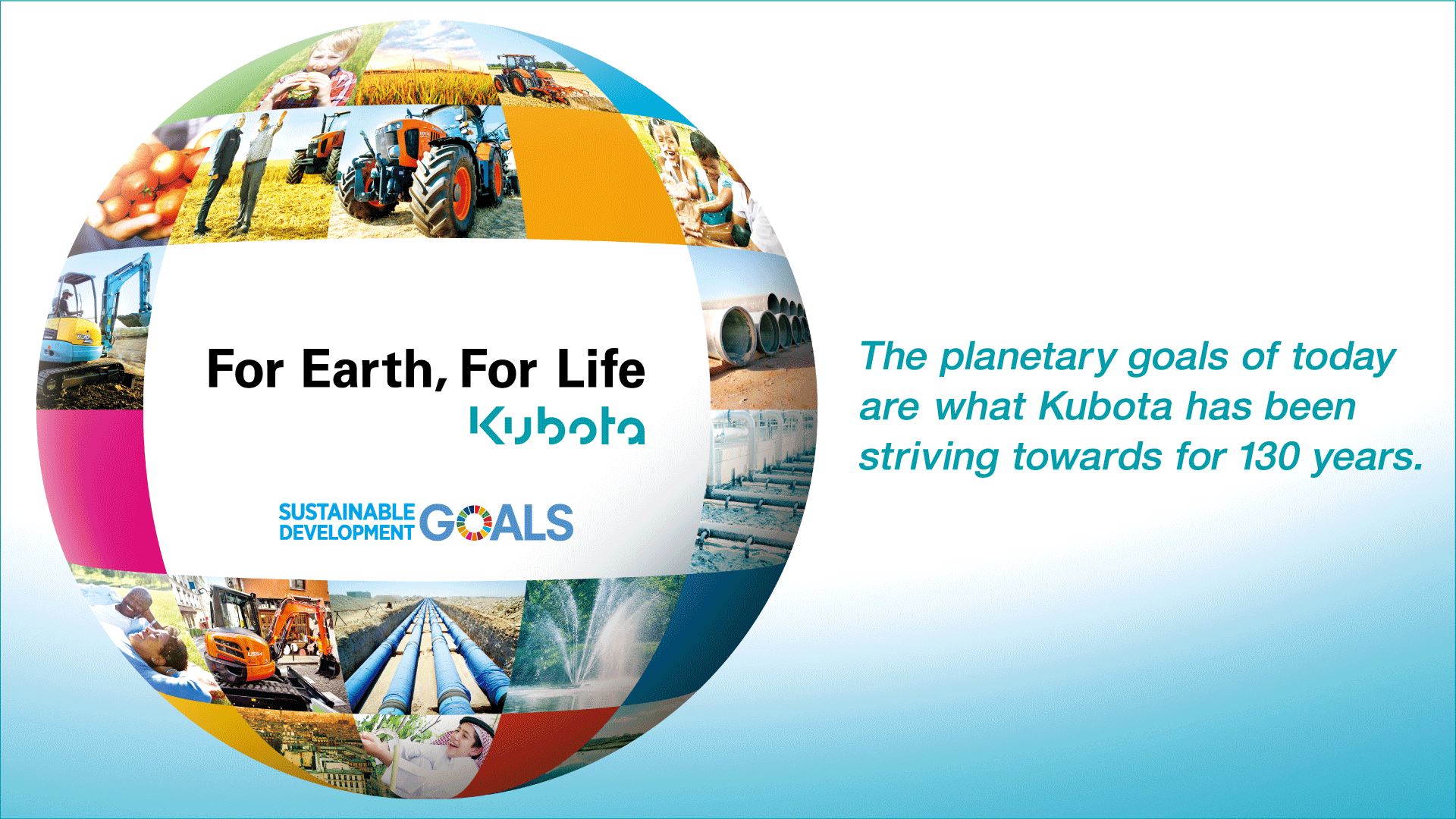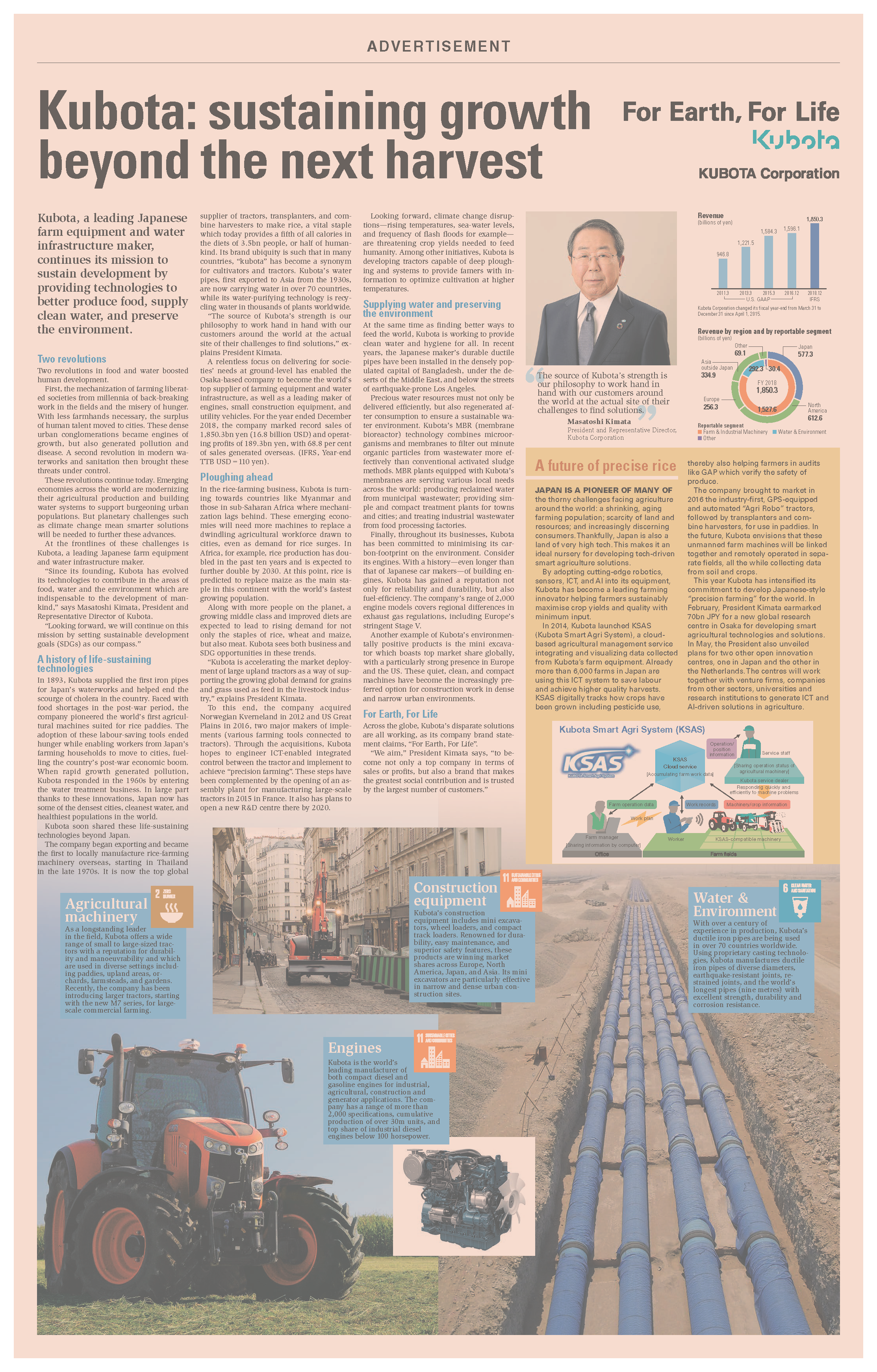Published in Financial Times
June 29, 2019
Kubota: sustaining growth beyond the next harvest
Kubota, a leading Japanese farm equipment and water infrastructure maker, continues its mission to sustain development by providing technologies to better produce food, supply clean water, and preserve the environment.
Two revolutions
Two revolutions in food and water boosted human development.
First, the mechanization of farming liberated societies from millennia of back-breaking work in the fields and the misery of hunger. With less farmhands necessary, the surplus of human talent moved to cities. These dense urban conglomerations became engines of growth, but also generated pollution and disease. A second revolution in modern waterworks and sanitation then brought these threats under control.
These revolutions continue today. Emerging economies across the world are modernizing their agricultural production and building water systems to support burgeoning urban populations. But planetary challenges such as climate change mean smarter solutions will be needed to further these advances.
At the frontlines of these challenges is Kubota, a leading Japanese farm equipment and water infrastructure maker.
“Since its founding, Kubota has evolved its technologies to contribute in the areas of food, water and the environment which are indispensable to the development of mankind,” says Masatoshi Kimata, President and Representative Director of Kubota.
“Looking forward, we will continue on this mission by setting sustainable development goals (SDGs) as our compass.”
A history of life-sustaining technologies
In 1893, Kubota supplied the first iron pipes for Japan’s waterworks and helped end the scourge of cholera in the country. Faced with food shortages in the post-war period, the company pioneered the world’s first agricultural machines suited for rice paddies. The adoption of these labour-saving tools ended hunger while enabling workers from Japan’s farming households to move to cities, fuelling the country’s post-war economic boom. When rapid growth generated pollution, Kubota responded in the 1960s by entering the water treatment business. In large part thanks to these innovations, Japan now has some of the densest cities, cleanest water, and healthiest populations in the world.
Kubota soon shared these life-sustaining technologies beyond Japan.
The company began exporting and became the first to locally manufacture rice-farming machinery overseas, starting in Thailand in the late 1970s. It is now the top global supplier of tractors, transplanters, and combine harvesters to make rice, a vital staple which today provides a fifth of all calories in the diets of 3.5bn people, or half of humankind. Its brand ubiquity is such that in many countries, “kubota” has become a synonym for cultivators and tractors. Kubota’s water pipes, first exported to Asia from the 1930s, are now carrying water in over 70 countries, while its water-purifying technology is recycling water in thousands of plants worldwide.
“The source of Kubota’s strength is our philosophy to work hand in hand with our customers around the world at the actual site of their challenges to find solutions,” explains President Kimata.
A relentless focus on delivering for societies’ needs at ground-level has enabled the Osaka-based company to become the world’s top supplier of farming equipment and water infrastructure, as well as a leading maker of engines, small construction equipment, and utility vehicles. For the year ended December 2018, the company marked record sales of 1,850.3bn yen (16.8 billion USD) and operating profits of 189.3bn yen, with 68.8 per cent of sales generated overseas. (IFRS, Year-end TTB USD=110 yen).
Ploughing ahead
In the rice-farming business, Kubota is turning towards countries like Myanmar and those in sub-Saharan Africa where mechanization lags behind. These emerging economies will need more machines to replace a dwindling agricultural workforce drawn to cities, even as demand for rice surges. In Africa, for example, rice production has doubled in the past ten years and is expected to further double by 2030. At this point, rice is predicted to replace maize as the main staple in this continent with the world’s fastest growing population.
Along with more people on the planet, a growing middle class and improved diets are expected to lead to rising demand for not only the staples of rice, wheat and maize, but also meat. Kubota sees both business and SDG opportunities in these trends.
“Kubota is accelerating the market deployment of large upland tractors as a way of supporting the growing global demand for grains and grass used as feed in the livestock industry,” explains President Kimata.
To this end, the company acquired Norwegian Kverneland in 2012 and US Great Plains in 2016, two major makers of implements (various farming tools connected to tractors). Through the acquisitions, Kubota hopes to engineer ICT-enabled integrated control between the tractor and implement to achieve “precision farming”. These steps have been complemented by the opening of an assembly plant for manufacturing large-scale tractors in 2015 in France. It also has plans to open a new R&D centre there by 2020.
Looking forward, climate change disruptions – rising temperatures, sea-water levels, and frequency of flash floods for example–are threatening crop yields needed to feed humanity. Among other initiatives, Kubota is developing tractors capable of deep ploughing and systems to provide famers with information to optimize cultivation at higher temperatures.
Supplying water and preserving the environment
At the same time as finding better ways to feed the world, Kubota is working to provide clean water and hygiene for all. In recent years, the Japanese maker’s durable ductile pipes have been installed in the densely populated capital of Bangladesh, under the deserts of the Middle East, and below the streets of earthquake-prone Los Angeles.
Precious water resources must not only be delivered efficiently, but also regenerated after consumption to ensure a sustainable water environment. Kubota’s MBR (membrane bioreactor) technology combines microorganisms and membranes to filter out minute organic particles from wastewater more effectively than conventional activated sludge methods. MBR plants equipped with Kubota’s membranes are serving various local needs across the world: producing reclaimed water from municipal wastewater; providing simple and compact treatment plants for towns and cities; and treating industrial wastewater from food processing factories.
Finally, throughout its businesses, Kubota has been committed to minimising its carbon-footprint on the environment. Consider its engines. With a history – even longer than that of Japanese car makers – of building engines, Kubota has gained a reputation not only for reliability and durability, but also fuel-efficiency. The company’s range of 2,000 engine models covers regional differences in exhaust gas regulations, including Europe’s stringent Stage V.
Another example of Kubota’s environmentally positive products is the mini excavator which boasts top market share globally, with a particularly strong presence in Europe and the US. These quiet, clean, and compact machines have become the increasingly preferred option for construction work in dense and narrow urban environments.
For Earth, For Life
Across the globe, Kubota’s disparate solutions are all working, as its company brand statement claims, “For Earth, For Life”.
“We aim,” President Kimata says, “to become not only a top company in terms of sales or profits, but also a brand that makes the greatest social contribution and is trusted by the largest number of customers.”

